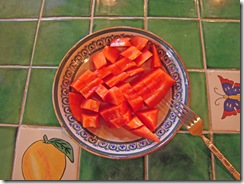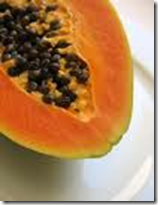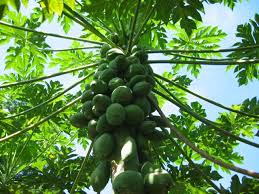
I love plump, palate-pleasing papaya and can eat this fruit in astonishing quantities. I have eaten it most of my life, except for stints in cold so-called temperate climes from which I have fled. In Pátzcuaro I can buy my ripe papaya at the street market by Plaza Chica in every month of the year and I do not have to pay a king’s ransom to end up with a greenish, unripe, tasteless fruit.
Here are some exciting facts to wade through on your way to the anecdotes following. The probable origin of the papaya is Mexico and Central America. Even though it looks like a tree, the papaya plant is classified as a large herb, Herbaceous perennial. It grows worldwide in tropical climates. Papayas are the only natural source of papain, which naturally aids digestion. It breaks down protein and cleanses the digestive track so that less food metabolizes as fat.

Papayas are rich in vitamin C, folate, and potassium, as well as providing fiber, vitamin A, vitamin E, the eye-saving carotenoids lutein and zeaxanthin, and lycopene. For nutritional value, papayas rank in the top three fruits. They have 13 times more vitamin C and more than 2 times the potassium of apples; they have 4 times more vitamin E than both apples and oranges. All that and it tastes good, too.
Did you know that papain is the tenderizing ingredient in Adolph’s meat tenderizer? Check the label in a store somewhere sometime. In Tahiti we used to use the papaya leaf to tenderize a tough cut of meat. We would buy “steaks” and wrap each one in a washed papaya leaf. We then placed the packets in the refrigerator overnight and the next day, voilà, we had tender steaks instead of having to attack the slabs with our machetes. If we left the meat in the leaves for a second day, I accidentally found out that it had begun to predigest—rather slimy and not at all appetizing.

On a holiday week-end, when we had more time off from work, we would hike two hours past the end of the road on Tahiti-Iti (the little part of the island’s figure 8) and camp by a river and waterfall. There we would spear fish and grill them on coral heated in a wood fire. Once a hapless feral chicken showed itself and it was hunted down with a fishing spear-gun. It was a tough, wiry bird, before and after its untimely demise. I shinnied up the trunk of a papaya “tree” and picked several green papayas. We peeled and seeded them and cut them up like squash. We simmered the chicken with chopped onions and garlic which we had brought, and the green papaya. The papaya tasted like squash and it tenderized the chicken beautifully. Healthy and tasty over rice.
When my children were infants, to introduce fruit with vitamin A and C into their diet, I would scrape the papaya flesh with a spoon and feed the resulting purée to them. Much less acid than orange juice, babies can have papaya when they are tiny. They digest it well and it is very good for them.
In Patzcuaro I eat papaya almost every morning (I confess that I do like variety from time to time). I am so spoiled. Maybe ripe, voluptuous mangos mañana…



4 comments:
I didn´t know that.
I like papaya, but less than you do.
A perfect papaya is a rare jewel. The overripe ones have a fetid odor. Lately I've been enjoying papaya more than I used to.
But overall, a mango is more voluptuous, but an avocado is more versatile.
Saludos,
Don Cuevas
Well said. And we are fortunate to be able to degust all three.
I also love papayas and didn't know the papaya plant was classified as a herb. I had the luck of taking photos of a papaya flower once. I love papayas although I have to admit I love guavas, mamey fruit and zapote negro better. But my favorite of all I have tased in Mexico so far is petayas!
Heather
Post a Comment